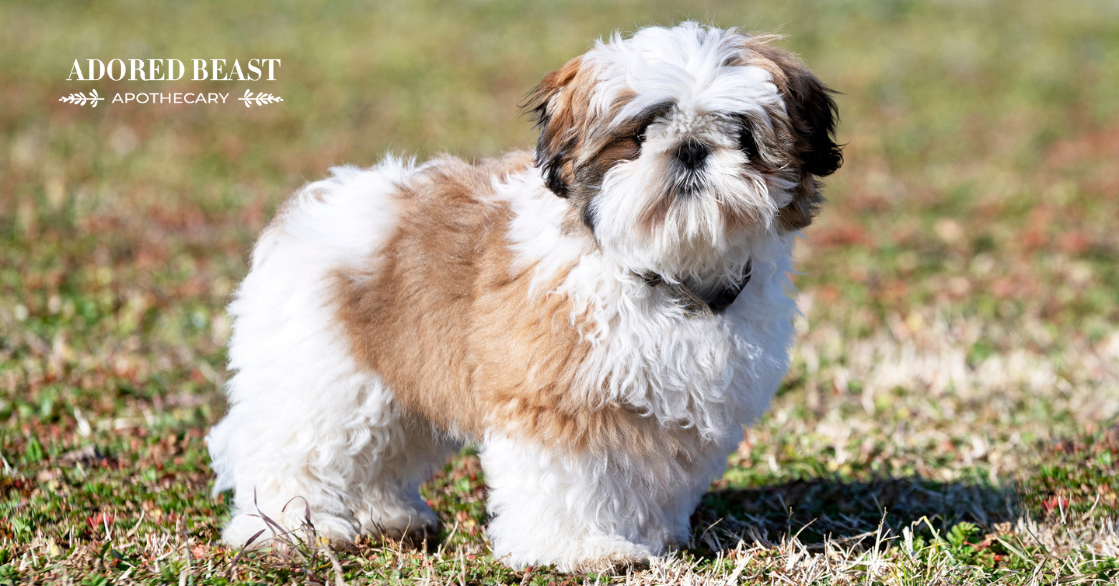When something seems totally off with your dog – maybe they’re stumbling, acting confused, or having trouble walking – it can be terrifying. In these cases, most of us make a trip to the emergency clinic (and rightly so).
While there are many possible causes, one condition that can affect the central nervous system is Meningoencephalomyelitis of Unknown Origin, often referred to as MUO in dogs.
This inflammatory disease can progress quickly, so understanding what it is and how to treat it (both conventionally and naturally, if possible) is key to getting your dog the help they need as soon as possible.
What is MUO in Dogs?
MUO is an umbrella term for a group of non-infectious, inflammatory diseases that affect a dog’s brain, spinal cord, and meninges (the protective layers around the brain and spinal cord).
Unlike infections caused by viruses or bacteria, MUO has no known infectious cause, which is why it’s classified as “of unknown origin.” It’s believed to be immune-mediated, meaning the dog’s own immune system mistakenly attacks its central nervous system.
MUO is most common in young to middle-aged small-breed dogs, though it can occur in any breed. It is considered an uncommon but not rare neurological condition in dogs, meaning it doesn’t affect the general dog population frequently, but it’s one of the more common causes of inflammatory brain disease in veterinary neurology.
There are a few specific forms of MUO:
- Granulomatous meningoencephalomyelitis (GME)
- Necrotizing meningoencephalitis (NME)
- Necrotizing leukoencephalitis (NLE)
These forms are often grouped together because their symptoms, treatments, and disease mechanisms are very similar.
Signs and Symptoms of MUO in Dogs
Because MUO affects the brain and spinal cord, symptoms can vary widely depending on where inflammation occurs. Signs may appear suddenly or develop over several days or weeks.
Common symptoms include:
- Loss of balance or ataxia
- Weakness or paralysis in one or more limbs
- Seizures
- Head tilt or abnormal eye movements
- Walking in circles
- Changes in behaviour or personality
- Disorientation or confusion
- Neck or back pain
- Loss of vision
- Lethargy or collapse
These symptoms can overlap with other neurological issues, so MUO cannot be diagnosed based on signs alone.
How MUO is Diagnosed
There’s no single test that confirms MUO. Diagnosis involves ruling out other possible causes of neurological disease, such as infections, tumors, trauma, or side effects of drugs like Librela or the rabies vaccine.
Veterinarians, often in collaboration with a veterinary neurologist, may use the following diagnostics:
- Physical and neurological exam: To identify which parts of the nervous system are at play.
- MRI (magnetic resonance imaging): This is the most useful imaging tool for detecting inflammation in the brain or spinal cord.
- Cerebrospinal fluid (CSF) analysis: A spinal tap can show increased white blood cells and protein levels, which indicate inflammation.
- Infectious disease testing: To rule out conditions caused by viruses, bacteria, or fungi.
A definitive diagnosis of the exact MUO subtype can only be made through a biopsy, which is incredibly invasive, but this is rarely done during a dog’s lifetime. In most cases, your vet will base a diagnosis on clinical signs, MRI, and CSF findings.
A note from Julie: “Sometimes MUO in dogs can look like vestibular syndrome, which is usually in older dogs, but I have seen it in dogs as young as 5. The big thing with this is not letting it go too long with the wrong diagnosis. Ask your vet how fast you should see improvement, what the signs are that things are getting better or worse. With MUO, ask to see a specialist ASAP if your dog is not responding or if they are getting worse at all.”
Conventional Treatment Options
Because MUO is an immune-mediated condition, the primary approach to conventional treatment is to suppress the immune system to reduce inflammation and prevent further damage to the nervous system.
Common treatment options include:
- Corticosteroids (such as Prednisone): Often the first line of treatment to rapidly reduce inflammation.
- Immunosuppressive drugs: Medications such as Cytarabine, Cyclosporine, or Mycophenolate mofetil may be used alongside steroids for stronger immune suppression or to help taper steroid doses over time.
- Seizure medications: If seizures are present, your vet may prescribe anticonvulsants.
- Supportive care: This may include IV fluids, pain management, physical therapy, and hospitalization in severe cases.
A Holistic Approach to Understanding
Several natural approaches focus on supportive measures to complement conventional treatments and improve your animal’s quality of life.
But first, you need to take a holistic approach to the understanding of what could potentially be behind it. The way Julie has always approached any kind of “unknown origin” or autoimmune disease is by looking at possible causes, including:
- A potential vaccine reaction, especially the rabies vaccine. The fact that we still do not do size-dependent dosing is very concerning in 2025.
- The cumulative effect of multiple drugs given for allergies, arthritis, infections, flea and tick medications.
- Sensitivity to a single drug (example, Librela – the side effects of which look very similar to this disease).
- Stress – has the dog been rehomed, was there an uprooting divorce, a death, did they move away from a friend?
- Trauma – hit by a car or an accident or an injury.
All of these things and more could be a cause or the last drop in the bucket that sends your dog’s body into such a high state of alert that it then starts to attack itself… AKA “Diseases of Unknown Origin” or autoimmune disease.
Addressing the Issue Naturally with Homeopathy
Once you’ve narrowed down a potential trigger, homeopathy can be a wonderful tool to address each one individually. The great thing about this is that homeopathy has no contraindication with immunosuppressive drugs, so it is very safe to use alongside your veterinarian’s recommendations.
- If it could have been triggered by a vaccine, then the remedies of choice would be Thuja and Silica (the remedies found in our Reblancer). Give these 3 times a day for 5 days. If it was the rabies vaccine, choose Lyssinum, given 3 times over the course of 24 hours, then stop and monitor.
- If you feel it was drug, medication or flea and tick induced a great remedy to start with is Nux Vomica 30C, three times a day for 5 days.
- If it could be potential stress the remedies are Natrum Muriaticum 200C if the dog is more reserved and wants to be alone, or Ignatia 200C if they are more anxious, stressed out, or clingy from grief.
- If you believe it’s trauma related, the remedies of choice would be Arnica 200C and Aconite 200C (You’ll find these in Your Go 2), 3 times a day for 5 days.
Always work alongside your veterinarian and a qualified animal homeopath, if possible.
Other Natural Support
In addition to homeopathy, there are several natural supplements that can support dogs with MUO.
1. Natural Immune Modulators
Immune modulators are substances that balance the immune system. They do NOT increase the immune system. You don’t want to do that because your dog’s immune system is already on high alert!
- Larch arabinogalactan can enhance immune cell activity, such as natural killer cells and macrophages and can help fight infection. You can find larch in many of our probiotics, from Love Bugs to Gut Soothe.
- Probiotics can positively influence and regulate immune responses. They do this by interacting with immune cells in the gut, which can lead to both pro-inflammatory and anti-inflammatory effects depending on the specific probiotic strain and the context of the immune system’s needs. Look for species-oriented like Fido’s Flora and The Wolf.
- Medicinal mushrooms like turkey tail and chaga work to modulate the immune system. They contain polysaccharopeptides that can both stimulate and suppress immune responses as needed, which helps the body maintain a healthy immune balance.
- Phytoplankton is an immune modulator, and research suggests it can both sustain and improve immune function by lowering pro-inflammatory cytokines. It contains bioactive lipids that can regulate immune responses, and it is being studied for its potential in managing inflammatory diseases.
2. Diet
If your dog is on an immunosuppressive drug, it is best to stick with a home-cooked diet or to cook your raw food (make sure there’s no bone in this case). If these options don’t work, try to find the cleanest processed food you can find so the body can concentrate on healing and not dealing with added chemicals or toxins from some commercial-based diets.
A note from Julie: “In my 25 years of practice in my veterinary clinics, I always found that with severe autoimmune disease or any disease of unknown origin, animals do the best under the care of veterinary clinics that either do integrative medicine or who will work with the practitioner to provide an integrative approach.”
Prognosis
The prognosis for dogs with MUO varies depending on the severity of the disease, how quickly it’s diagnosed, and how well the dog responds to treatment. Some dogs make a good recovery and live normal lives, while others may have permanent neurological deficits or experience relapses. While MUO can be life-threatening, many dogs respond well to treatment, especially when diagnosed early. Some require long-term immunosuppressive therapy, while others may go into remission.
With MUO in dogs, early intervention gives the best chance of a positive outcome, so if you ever notice neurological changes in your dog, no matter how small, it’s important to seek veterinary care immediately. You can support your adored beast and help them live the best life possible.












